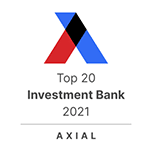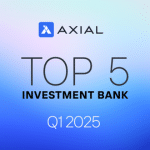
Deal volume and deal value metrics are on the rise in the U.S., and FOCUS believes the M&A market will continue this trend into 2015 – and even beyond. While numerous factors influence the completion of an M&A deal, at every size and in every industry, we believe the availability of capital and the decision-makers’ confidence in the future are critical drivers of transaction activity.
With both of these factors in positive territory and expected to stay there, supported by conditions that range from low interest rates and low oil prices to high consumer confidence levels, FOCUS sees a strong year ahead for deal-making activity.
In economic markets supported by strengthening fundamentals, many deals are available in which both buyers and sellers can consider themselves “winners” – the ultimate goal of a successful transaction. A pipeline of these kinds of transactions supports the view that 2015 will be another growth year – and our inventory of middle market deals, scheduled to close in 2015, indicates FOCUS’ experience should mirror that of the overall market.
Market Activity: 2014 Showed Growth in Value and Volume
The M&A market experienced an uptick in deal volume, and a dramatic increase in deal value in 2014. According to Ernst and Young “…the dynamics that made 2014 a record year for U.S. deal making will continue into the New Year, pointing to ongoing buoyancy for the M&A market in 2015. U.S. deal volume rose 5.1% in 2014, with 10,889 deals compared to 10,360 in 2013.1 Meanwhile, value soared to $1.6 trillion in 2014, up 40.7% from $1.1 trillion in 2013. This trend is likely to stay on course; 81% of executives expect the deal market to improve in the next 12 months.”2
We also find the survey data below from KPMG confirms our review of market activity and prospects. KPMG conducted an extensive survey on M&A issues with 735 M&A professionals from U.S. corporations, private equity firms (PEGs), and investment banks, and published the following survey results:3
[feature_box]Survey participants were asked a series of 26 questions, regarding their participation in M&A transactions in 2013, 2014, and their expectations for 2015:- 79% of companies said they completed 1 or more transactions in 2014, compared to 66% in 2013
- 17% of companies said they completed 2 or more transactions in 2014, compared to 12% in 2013
- 82% of companies said they are planning 1 or more transactions in 2015
- 19% of companies said they are planning 2 or more transactions in 2015
- Large cash reserves: 40%
- Opportunities in emerging markets: 19%
- Availability of favorable credit: 16%
- Improved consumer confidence: 13%
- Improving equity markets: 8%
- Healthcare/Pharma/Life-sciences: 84%
- Tech/Media/Telecom: 62%
- Energy/Oil & Gas: 36%
- Consumer Markets: 34%
- Financial Services: 30%
- Manufacturing: 24%
FOCUS Top 10 List Supporting Strong M&A in 2015
FOCUS has devoted significant thought and analysis to this subject, and has identified the top10 factors we believe should support strong M&A activity in 2015:
- Debt is readily available at historically attractive rates and terms, from banks and non-bank lenders.
- Strategic and financial buyers have an abundance of cash available for equity investment.
- The U.S. Federal government is on cruise control, given that the parties must agree in order to pass sweeping changes. Most business leaders believe changes will be incremental and less likely to damage the business climate. In other words, leaders believe the rules of the economic game will be less likely to cause surprises, until after the next election cycle in Q4 2016.
- There is pent up demand from both buyers and sellers who planned transactions for 2010 through 2013, which were then aborted. Much of this pent up transaction demand is driven by demographics; the baby boomer business owners whose retirement plans were delayed, as well as the growth stage companies with acquisition plans thwarted by a lack of acceptable financing. Many of these deals still “need to occur,” and will eventually come to market in the current M&A market cycle.
- Given the current oversupply of petroleum and weak demand in Europe and the developing economies, low energy prices are likely to continue for a year or more. Other than for companies related to energy production, low energy prices stoke profits and consumer spending.
- The U.S. economy has produced enough jobs to bring the unemployment rate down to the 5% range. In prior cycles, this would have indicated the economy is approaching full employment, and wage inflation could be around the corner. However, the U.S. Bureau of Labor Statistics (BLS) revised the unemployment calculations in 2010 and changed the definition of long term unemployment4.Some experts believe the figures should be approximately 3% higher, if we accounted for the long term unemployed who have dropped out of the job hunt, and others who are unintentionally part time workers. This available labor pool should delay wage inflation for many quarters as the work force expands to meet employment demand.
- Consumer confidence and spending are strong and trending up, providing growth across the board benefiting many industries.
- New home construction and development has not yet contributed much to this economic recovery cycle; this industry’s anemic performance to date indicates a strong growth opportunity for jobs and profits as that market rebounds in the future.
- The Federal Reserve seems very reluctant to move interest rates up, and now appears to be more focused on stimulating economic growth, rather than guarding against inflation.
- We see little second guessing and deal jitters on either side of the transaction table; buyers and sellers are both in a decisive mood, and are committed to getting deals done.
Both the KPMG survey results and the “FOCUS Top 10 List Supporting Strong M&A in 2015” demonstrate why 2015 should be a robust year for M&A. Of course, unforeseen wars or natural disasters could have a material effect on this expected outcome.
Ultimately the M&A market is fueled by the availability of capital, and the decision makers’ confidence in the future. Looking forward to the New Year, it appears that both of these are in ample supply!
[1] Dealogic data as of 11/30 assessed 12.1/14
[2] News Release, 12/8/14, Ernst & Young LLP, New York
[3] “KPMG M&A Outlook Survey Report: The Boom is Back: M&A Reemerges as Leading Growth Strategy,” KPMG LLP, 2014
[4] How Is the Unemployment Rate Calculated? Surveyors from the Bureau of Labor Statistics (BLS) visit 60,000 households every month and ask a number of questions to determine someone’s employment status. If someone works full-time, part-time, or is self-employed, they are considered employed. If someone does not have a job of any kind, but has been looking for one for the past four weeks, they are considered unemployed. If someone does not have a job and isn’t looking for one, they are considered outside of the labor force. Source: Moneycrashers.com accessed 12/30/14













